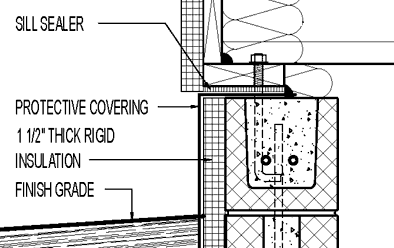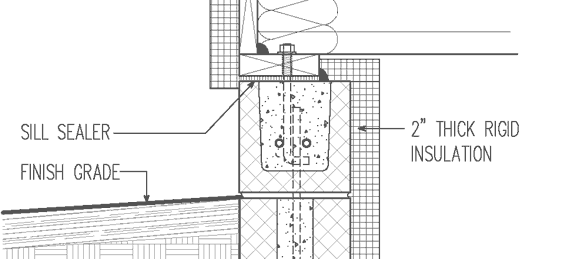Have you ever heard the saying, if you could just keep the water out of homes, they would last forever. Well there is one more character out there which can be just as insidious & even more crafty…

This map goes by many names but most refer to it as simply TIPS or TIP Zones which shows the possibility that termites might be an issue / active in your area. This was created by the US Forest Service back in the 60’s to help educate & inform homeowners as to the dangers of termites and the signs of infestation. The ICC has adopted this map to determine what building code requirements are required in which areas much like the snow load, wind, & other maps or charts. (For more – see the Legal Section)
Interesting Facts:
Out of the 2,300 species known worldwide, there are approximately only 45 in the US. The four main types talked about are drywood, dampwood, & subterranean with the “Formosan” being one of the most destructive and well known. The drywood & dampwood species are generally locked in to specific geographic areas since they generally do not live or move through the soil & cannot handle cold weather. However, even though the Formosan is part of the subterranean species, (requiring soil to live in) it does not require soil to live in as it forms “cartons” or nests for the colony to survive in.
- Like bees – termites are social insects that live in colonies with caste systems based on their roles and responsibilities: reproductives, workers and soldiers
- The worker and soldier termites are blind
- As many termites are blind & they have yet to invent light they communicate through pheromones and banging their heads to signal others
- The enemy of my enemy is my friend – well not really as ants can cause enough damage themselves but if you’re curious, a termites main enemy is the ant
- Just like other insects – they do have their uses & our important for breaking down tough plant fibers, recycling dead and decaying trees turning them into new soil
- They actually do not “eat” wood but rather really on a symbiotic relationship with another single-cell organisms to digest the wood/cellulose
- Termites are actually very clean as they clean each other & even do what dogs are famous for, namely eat poop. Part of this has to do with that needed symbiotic relationship as the bacteria is not naturally occurring in them.
- They only need a space of 1/32 of an inch to sneak in & start their work
Termite Prevention:
 Termite control is covered under Section 318 of the IRC (Subterranean termite control methods.) In areas subject to damage from termites per the TIP Zone map above one must use on or more of the following options (subject to AHJ): Termite control is covered under Section 318 of the IRC (Subterranean termite control methods.) In areas subject to damage from termites per the TIP Zone map above one must use on or more of the following options (subject to AHJ):
|
Got Foam?
 In many ways foam has gotten a bad wrap as one can see where termites & other creatures have burrowed through foam as compared to other products like fiberglass & cellulose which they simply push out of their way. Due to this they have some special language in the codes which can prevent one form using this typical detail;
In many ways foam has gotten a bad wrap as one can see where termites & other creatures have burrowed through foam as compared to other products like fiberglass & cellulose which they simply push out of their way. Due to this they have some special language in the codes which can prevent one form using this typical detail;
 & theoretically requires one to do this… For many that live in “Termite area” they know this also won’t fly & is something we will cover in another article.
& theoretically requires one to do this… For many that live in “Termite area” they know this also won’t fly & is something we will cover in another article.
 R318.4 Foam plastic protection; “In areas where the probability of termite infestation is “very heavy” extruded and expanded polystyrene, polyisocyanurate and other foam plastics shall not be installed on the exterior face or under interior or exterior foundation walls or slab foundations located below grade. The clearance between foam plastics installed above grade and exposed earth shall be at least 6 inches.” R318.4 Foam plastic protection; “In areas where the probability of termite infestation is “very heavy” extruded and expanded polystyrene, polyisocyanurate and other foam plastics shall not be installed on the exterior face or under interior or exterior foundation walls or slab foundations located below grade. The clearance between foam plastics installed above grade and exposed earth shall be at least 6 inches.”
The three exceptions:
|
Chemical Based Systems:
Chemical treatment zones sprayed around the home (aka chemical barriers) is essentially “the standard” used by most new homebuilders. Generally one of two types of soil treatments are used; either a repellent type or a termiticide. The repellent type is applied to the soil around the perimeter of a house to help deter termites from entering the treated area but is not meant to kill. The big issue is that any gaps in the treatment area can allow termites to enter the home with impunity. A termiticide on the other hand is not meant to block but rather to be a slow acting agent (kills with 24 hours to 11 days) which is brought back to the colony to kill them all off.
Termiticides are applied either to the soil or other areas as a pre-construction &/or post-construction treatment. Most prefer the pre-construction treatment as it is considered the most effective and cost-efficient measure. In many ways, this is because the treatment can be applied more easily to the different locations needed eliminating one trying to crawl around to reach all the nooks & crannies.
The biggest issue though is that both of these options only have a useful life of 15 years or less assuming the termites do not find a way through disturbed soil or are able to build mud tunnels over the sprayed areas (mulch beds are a popular means). Assuming you can get the full 15 years, after that period is up, you had better have another solution up your sleeve.
This brings us to the bait stations that are strategically placed around the perimeter of the house. Essentially, they leave a nice piece of grilled steak (dried wood) in the station & one waits for activity. If there is no activity there & no evidence shows up elsewhere, you are good to go. If activity is discovered, they swap out the steak with one with a special rub aka a termiticide to eliminate the colony.
Wood Alternatives:
If there is no food, or said food smells unappetizing… the termites have no reason to enter is essentially the next premise per the codes.
- Pressure Treated wood is used mainly for decks or where wood meets masonry. Building a home completely out of pressure treated wood designed for exterior use is not really a good idea and introduces more issues than what one is trying to solve.
- With that there are companies out there that do have products where fire retardants, mildewcides, &/or termitcides are infused or applied to the wood before or after they are kiln dried. Not only are these products designed for these areas but also one is almost guaranteed that your house will be the talk of the town as they come in some interesting colors.
- The final one mentioned in the codes is steel studs, which must be used for not only the walls, but also roof & floor framing.
Termite Shields / Barriers:
A termite shield is essentially a physical barrier that a termite cannot go through. With that, the catch is most “shields” or barriers are not meant to shield or to protect your home by stopping them from entering… Nope, properly designed & installed shields are meant to force the termites to find another route where they can be seen (i.e. build mud tunnels) and thus eradicated.
- A termite shield is generally made of galvanized metal or copper & used for foundations, posts, & piers
- Plastic termite shields are commonly used around pipes where metals would not work as well
- Plastic sheets & even some foams used for under the slab or other locations can also be impregnated with a termiticide or repellant – these generally have a 20 year life span
- Stainless steel mesh is a woven barrier which is generally used under slabs for termite prevention where pipes come up & to prevent them from burrowing through the foam to enter via a crack in the concrete floor
Luau anyone?
The final two barriers are primarily used on islands like Hawaii. They are a sand barrier & a Basaltic (volcanic rock) barrier. The sand & basalt used requires a specific particle size (1.6 to 2.8 mm) which not only blocks them from building tunnels but also fills in any gaps. Just like the repellant spray above, any gaps or issues in the barrier gives the termites access. With that a properly designed barrier like this or the ones above, coupled with routine inspections (which is required for all treatments) can give you a lifetime of termite free living.
